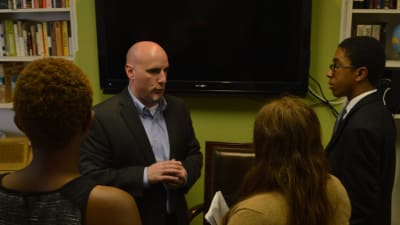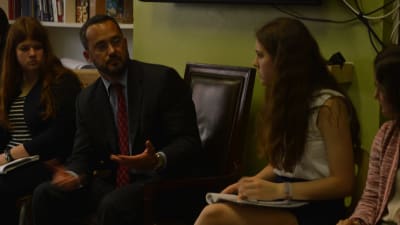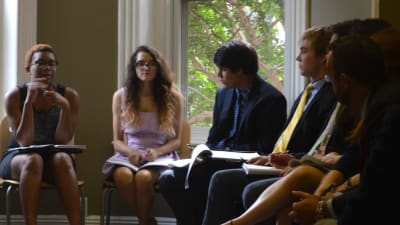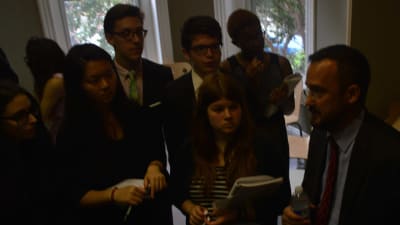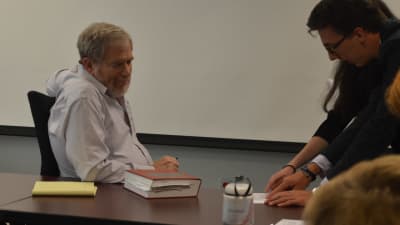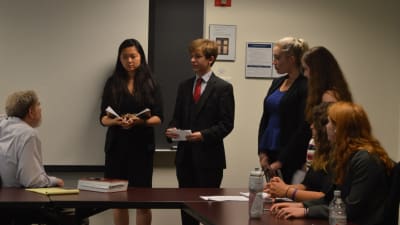Summer 2015 meets NRA President, Constitutional warriors during 2nd Amendment case study
With the events in Charleston, South Carolina and Chattanooga, Tennessee as sober fodder, Summer 2015 took aim at the Second Amendment last week. The case study led to many robust exchanges and a great deal of reflection.
On Monday the students heard an overview of the key issues that the Supreme Court faced in Heller. (From the list the students received:
- What does “Right of the People” mean? Is the right individual or collective? 2) What does “Keep and Bear Arms” mean? What kind of arms? For what purpose? 3) What is a “Well-Regulated Militia”? A state-organized entity or a group of pre-existing individuals? 4) What does “Security of a Free State” mean? The U.S. or an individual state?
- What is the relationship between the prefatory and operative clauses?
- What does precedent say, if anything? 7) What else is important to consider?) A heated discussion ensued that would continue throughout the week.
They also received their assignment: on Friday, in teams, they would act as law clerks advising a Supreme Court Justice on the Heller case. The Justice would be played by a leading expert (they were not told which expert so they would not tailor their opinions accordingly).
Our first guest, Ladd Everitt, is the Communications Director for the Coalition to End Gun Violence paid a visit. Everitt, another SEGL regular, argued from political, ethical, and legal perspectives that gun control legislation is essential. (Want to see Everitt on The Daily Show? Click here.)
Our next guest was Clark Neily, a longtime SEGL favorite and the attorney who conceived of and organized the plaintiffs for the Heller case, joined us for an engaging and intellect-bending sessions. Neily said he used the same strategy Thurgood Marshall used to bring the Brown v. Board of Education case to trial. (Neily was at the attorneys table in front of the justices during the Supreme Court oral argument.) He works as a public interest lawyer for the Institute for Justice, a libertarian institution; along with convincing arguments against the DC law, he answered several questions about his libertarian-esque orientation.
The following morning, we boarded a small bus and drove to the national headquarters of the National Rifle Association. We began with a guided tour of the National Firearms Museum (want to see a gun carried on the Mayflower, or one used in a Dirty Harry movie, or one given to Princess Diana by the British on the occasion of her marriage?) and then met with former NRA President David Keene. Keene (who remains on the NRA board and who edits the Washington Times opinion pages) is a grandfatherly and passionate advocate for gun rights. His perspective is one many of our students had not heard but learned to appreciate. Most came away with their political views intact, but with conviction that the other side’s view were well-reasoned. (This, of course, is at the heart of SEGL’s pedagogy: the belief that understanding and empathizing builds far more progress than discrediting and destroying.)
In groups of four, the students then prepped their arguments. This sort of intellectual task is quite different from most that they have received in high school: the answers are not in the back of the book and the format is not on the assignment sheet. It is the kind of challenge that requires students to form, reject, refine, and reform their arguments again and again. It is an exhausting and exhilarating process (and helps the students understand whether they would enjoy law school!).
To end our case, the students traveled to Georgetown Law Center to meet with their “Justice”: Professor Louis Seidman, a leading and frequently-published Constitutional law expert who once clerked for Thurgood Marshall. Professor Seidman played the role of a Justice with voracious vigor: he pulled no punches as, group by group, the students presented their opinions. At every opportunity, Seidman interrupted with penetrating and dissenting questions that kept the students on their toes. Wasn’t the Framers’ intent to allow muskets, not machine guns? How can the Second Amendment apply to DC, which isn’t a State? Can you really argue that someone can have a gun but only to use when called to participate in the militia? He also, when prompted, shared his personal (and controversial) view that the Constitution should be abolished.
The session helped students hone their ability to think and speak on their feet, to question the premises of an adversary, and to collaborate as a team under pressure. More important, Seidman’s questions helped the students learn a new way of thinking: to approach Constitutional issues from a legal framework, not a political or emotional one. (“It’s not my job as a judge to decide what I think is best,” he said at one point. “It is my job to interpret what the Constitution says.”) It is here that the students may have learned the most.
Next up: longtime lead Hillary Clinton speechwriter Lissa Muscatine!

